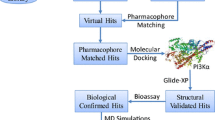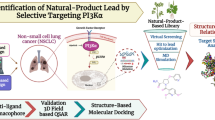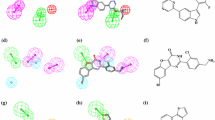Abstract
The PI3KCA gene functions by activating cascade signaling pathways leading to cell proliferation, survival, and growth. Being one of the frequently aberrant kinase in various malignancies, isoform selectivity among kinases remains a challenging aspect. In present study, efforts have been made to conceptualize determinants that are responsible for PI3Kα inhibition. Drug design techniques such as 3D-QSAR models, e-pharmacophore models, and shape-based screening utilities were derived from set of molecules and clinical trial candidates. QSAR models were validated using structure-based cross validation technique. Further, ROC analysis and molecular dynamics simulations were performed for the selected crystal structure for its validation. Virtual screening was employed for selection of hits and based on interaction pattern, binding affinity, and energy scores three hits with central scaffold as theino[2,3-d] pyrimidine (SS-RM-03), theino[3,2-d] pyrimidine (SS-RM-04), and oxadiazole (SS-RM-05) have been identified. The screened hits were then subjected to molecular dynamics simulations and quantum mechanical calculations. Further structure-guided methodology was adopted for analyzing prominent features of the hits and was correlated using common site feature analysis. The developed models along with structural features provided by molecular dynamics simulations serve as tools for identification of structural features essential for PI3Kα inhibition. Molecular determinants using diverse in silico tools have been identified which will facilitate drug discovery programs worldwide.














Similar content being viewed by others
References
Manning G, Whyte DB, Martinez R, Hunter T, Sudarsanam S (2002) The protein kinase complement of the human genome. Science (New York, NY) 298(5600):1912–1934. https://doi.org/10.1126/science.1075762
Yu JSL, Cui W (2016) Proliferation, survival and metabolism: the role of PI3K/AKT/mTOR signalling in pluripotency and cell fate determination. Development 143(17):3050
Bharate SB, Sawant SD, Singh PP, Vishwakarma RA (2013) Kinase inhibitors of marine origin. Chem Rev 113(8):6761–6815. https://doi.org/10.1021/cr300410v
Cohen P (2002) Protein kinases--the major drug targets of the twenty-first century? Nat Rev Drug Discov 1(4):309–315. https://doi.org/10.1038/nrd773
Cortes JE, Talpaz M, O'Brien S, Faderl S, Garcia-Manero G, Ferrajoli A, Verstovsek S, Rios MB, Shan J, Kantarjian HM (2006) Staging of chronic myeloid leukemia in the imatinib era: an evaluation of the World Health Organization proposal. Cancer 106(6):1306–1315. https://doi.org/10.1002/cncr.21756
Trela E, Glowacki S, Błasiak J (2014) Therapy of chronic myeloid leukemia: twilight of the Imatinib era? ISRN Oncol 2014:9. https://doi.org/10.1155/2014/596483
Wu M, Akinleye A, Zhu X (2013) Novel agents for chronic lymphocytic leukemia. J Hematol Oncol 6(1):36. https://doi.org/10.1186/1756-8722-6-36
Polivka Jr J, Janku F (2014) Molecular targets for cancer therapy in the PI3K/AKT/mTOR pathway. Pharmacol Ther 142(2):164–175. https://doi.org/10.1016/j.pharmthera.2013.12.004
Kang S, Bader AG, Vogt PK (2005) Phosphatidylinositol 3-kinase mutations identified in human cancer are oncogenic. Proc Natl Acad Sci U S A 102(3):802–807. https://doi.org/10.1073/pnas.0408864102
Wen PY, Lee EQ, Reardon DA, Ligon KL, Alfred Yung WK (2012) Current clinical development of PI3K pathway inhibitors in glioblastoma. Neuro-Oncology 14(7):819–829. https://doi.org/10.1093/neuonc/nos117
H-f Z, Wang J, Shao W, C-p W, Z-p C, To S-sT, Li W-p (2017) Recent advances in the use of PI3K inhibitors for glioblastoma multiforme: current preclinical and clinical development. Mol Cancer 16:100. https://doi.org/10.1186/s12943-017-0670-3
Fransecky L, Mochmann LH, Baldus CD (2015) Outlook on PI3K/AKT/mTOR inhibition in acute leukemia. Mol Cell Ther 3:2. https://doi.org/10.1186/s40591-015-0040-8
Fruman DA, Rommel C (2014) PI3K and Cancer: lessons, challenges and opportunities. Nat Rev Drug Discov 13(2):140–156. https://doi.org/10.1038/nrd4204
Woo YM, Shin Y, Lee EJ, Lee S, Jeong SH, Kong HK, Park EY, Kim HK, Han J, Chang M, Park J-H (2015) Inhibition of aerobic glycolysis represses Akt/mTOR/HIF-1α Axis and restores tamoxifen sensitivity in antiestrogen-resistant breast Cancer cells. PLoS One 10(7):e0132285. https://doi.org/10.1371/journal.pone.0132285
Ali K, Camps M, Pearce WP, Ji H, Rückle T, Kuehn N, Pasquali C, Chabert C, Rommel C, Vanhaesebroeck B (2008) Isoform-specific functions of phosphoinositide 3-kinases: p110δ but not p110γ promotes optimal allergic responses in vivo. J Immunol (Baltimore, Md : 1950) 180(4):2538–2544
Jackson SP, Schoenwaelder SM, Goncalves I, Nesbitt WS, Yap CL, Wright CE, Kenche V, Anderson KE, Dopheide SM, Yuan Y, Sturgeon SA, Prabaharan H, Thompson PE, Smith GD, Shepherd PR, Daniele N, Kulkarni S, Abbott B, Saylik D, Jones C, Lu L, Giuliano S, Hughan SC, Angus JA, Robertson AD, Salem HH (2005) PI 3-kinase p110beta: a new target for antithrombotic therapy. Nat Med 11(5):507–514. https://doi.org/10.1038/nm1232
Hirsch E, Katanaev VL, Garlanda C, Azzolino O, Pirola L, Silengo L, Sozzani S, Mantovani A, Altruda F, Wymann MP (2000) Central role for G protein-coupled phosphoinositide 3-kinase gamma in inflammation. Science (New York, NY) 287(5455):1049–1053
Park S, Chapuis N, Bardet V, Tamburini J, Gallay N, Willems L, Knight ZA, Shokat KM, Azar N, Viguie F, Ifrah N, Dreyfus F, Mayeux P, Lacombe C, Bouscary D (2008) PI-103, a dual inhibitor of class IA phosphatidylinositide 3-kinase and mTOR, has antileukemic activity in AML. Leukemia 22(9):1698–1706. https://doi.org/10.1038/leu.2008.144
Kong D, Yamori T (2007) ZSTK474 is an ATP-competitive inhibitor of class I phosphatidylinositol 3 kinase isoforms. Cancer Sci 98(10):1638–1642. https://doi.org/10.1111/j.1349-7006.2007.00580.x
Wallin JJ, Guan J, Prior WW, Lee LB, Berry L, Belmont LD, Koeppen H, Belvin M, Friedman LS, Sampath D (2012) GDC-0941, a novel class I selective PI3K inhibitor, enhances the efficacy of docetaxel in human breast cancer models by increasing cell death in vitro and in vivo. Clin Cancer Res 18(14):3901–3911. https://doi.org/10.1158/1078-0432.ccr-11-2088
Tiwary P, Mondal J, Berne BJ (2017) How and when does an anticancer drug leave its binding site? Sci Adv 3(5):e1700014. https://doi.org/10.1126/sciadv.1700014
Casasnovas R, Limongelli V, Tiwary P, Carloni P, Parrinello M (2017) Unbinding kinetics of a p38 MAP kinase type II inhibitor from Metadynamics simulations. J Am Chem Soc 139(13):4780–4788. https://doi.org/10.1021/jacs.6b12950
Valsson O, Tiwary P, Parrinello M (2016) Enhancing important fluctuations: rare events and Metadynamics from a conceptual viewpoint. Annu Rev Phys Chem 67:159–184. https://doi.org/10.1146/annurev-physchem-040215-112229
Srivastava S, Choudhary BS, Mehta P, Sukanya SM, Malik R (2018) Molecular dynamics insights for PI3K-δ inhibition & structure guided identification of novel PI3K-δ inhibitors. J Biomol Struct Dyn:1–24. https://doi.org/10.1080/07391102.2018.1489304
Mondal J, Tiwary P, Berne BJ (2016) How a kinase inhibitor withstands gatekeeper residue mutations. J Am Chem Soc 138(13):4608–4615. https://doi.org/10.1021/jacs.6b01232
Fleming KL, Tiwary P, Pfaendtner J (2016) New approach for investigating reaction dynamics and rates with ab initio calculations. J Phys Chem A 120(2):299–305. https://doi.org/10.1021/acs.jpca.5b10667
Bollag G, Tsai J, Zhang J, Zhang C, Ibrahim P, Nolop K, Hirth P (2012) Vemurafenib: the first drug approved for BRAF-mutant cancer. Nat Rev Drug Discov 11:873. https://doi.org/10.1038/nrd3847
Gkeka P, Evangelidis T, Pavlaki M, Lazani V, Christoforidis S, Agianian B, Cournia Z (2014) Investigating the structure and dynamics of the PIK3CA wild-type and H1047R oncogenic mutant. PLoS Comput Biol 10(10):e1003895. https://doi.org/10.1371/journal.pcbi.1003895
Gkeka P, Papafotika A, Christoforidis S, Cournia Z (2015) Exploring a non-ATP pocket for potential allosteric modulation of PI3Kα. J Phys Chem B 119(3):1002–1016. https://doi.org/10.1021/jp506423e
Rewcastle GW, Kolekar S, Buchanan CM, Gamage SA, Giddens AC, Tsang KY, Kendall JD, Singh R, Lee WJ, Smith GC, Han W, Matthews DJ, Denny WA, Shepherd PR, Jamieson SMF (2017) Biological characterization of SN32976, a selective inhibitor of PI3K and mTOR with preferential activity to PI3Kalpha, in comparison to established pan PI3K inhibitors. Oncotarget 8(29):47725–47740. https://doi.org/10.18632/oncotarget.17730
Zhao Y, Zhang X, Chen Y, Lu S, Peng Y, Wang X, Guo C, Zhou A, Zhang J, Luo Y, Shen Q, Ding J, Meng L, Zhang J (2014) Crystal structures of PI3Kα complexed with PI103 and its derivatives: new directions for inhibitors design. ACS Med Chem Lett 5(2):138–142. https://doi.org/10.1021/ml400378e
Sastry GM, Adzhigirey M, Day T, Annabhimoju R, Sherman W (2013) Protein and ligand preparation: parameters, protocols, and influence on virtual screening enrichments. J Comput Aided Mol Des 27(3):221–234. https://doi.org/10.1007/s10822-013-9644-8
Friesner RA, Banks JL, Murphy RB, Halgren TA, Klicic JJ, Mainz DT, Repasky MP, Knoll EH, Shelley M, Perry JK, Shaw DE, Francis P, Shenkin PS (2004) Glide: a new approach for rapid, accurate docking and scoring. 1. Method and assessment of docking accuracy. J Med Chem 47(7):1739–1749. https://doi.org/10.1021/jm0306430
Friesner RA, Murphy RB, Repasky MP, Frye LL, Greenwood JR, Halgren TA, Sanschagrin PC, Mainz DT (2006) Extra precision glide: docking and scoring incorporating a model of hydrophobic enclosure for protein-ligand complexes. J Med Chem 49(21):6177–6196. https://doi.org/10.1021/jm051256o
Halgren TA, Murphy RB, Friesner RA, Beard HS, Frye LL, Pollard WT, Banks JL (2004) Glide: a new approach for rapid, accurate docking and scoring. 2. Enrichment factors in database screening. J Med Chem 47(7):1750–1759. https://doi.org/10.1021/jm030644s
Dixon SL, Smondyrev AM, Knoll EH, Rao SN, Shaw DE, Friesner RA (2006) PHASE: a new engine for pharmacophore perception, 3D QSAR model development, and 3D database screening: 1. Methodology and preliminary results. J Comput Aided Mol Des 20(10–11):647–671. https://doi.org/10.1007/s10822-006-9087-6
Dixon SL, Smondyrev AM, Rao SN (2006) PHASE: a novel approach to pharmacophore modeling and 3D database searching. Chem Biol Drug Des 67(5):370–372. https://doi.org/10.1111/j.1747-0285.2006.00384.x
Jorgensen WL, Maxwell DS, Tirado-Rives J (1996) Development and testing of the OPLS all-atom force field on conformational energetics and properties of organic liquids. J Am Chem Soc 118(45):11225–11236. https://doi.org/10.1021/ja9621760
Jorgensen WL, Tirado-Rives J (1988) The OPLS [optimized potentials for liquid simulations] potential functions for proteins, energy minimizations for crystals of cyclic peptides and crambin. J Am Chem Soc 110(6):1657–1666. https://doi.org/10.1021/ja00214a001
Shivakumar D, Williams J, Wu Y, Damm W, Shelley J, Sherman W (2010) Prediction of absolute solvation free energies using molecular dynamics free energy perturbation and the OPLS force field. J Chem Theory Comput 6(5):1509–1519. https://doi.org/10.1021/ct900587b
Jacobson MP, Friesner RA, Xiang Z, Honig B (2002) On the role of the crystal environment in determining protein side-chain conformations. J Mol Biol 320(3):597–608
Jacobson MP, Pincus DL, Rapp CS, Day TJ, Honig B, Shaw DE, Friesner RA (2004) A hierarchical approach to all-atom protein loop prediction. Proteins 55(2):351–367. https://doi.org/10.1002/prot.10613
Bowers KJ, Chow DE, Xu H, Dror RO, Eastwood MP, Gregersen BA, Klepeis JL, Kolossvary I, Moraes MA, Sacerdoti FD, Salmon JK, Shan Y, Shaw DE (2006) Scalable algorithms for molecular dynamics simulations on commodity clusters. SC 2006 conference, proceedings of the ACM/IEEE, 11–17 Nov. 2006, pp 43–43. https://doi.org/10.1109/SC.2006.54
Saurat T, Buron F, Rodrigues N, de Tauzia M-L, Colliandre L, Bourg S, Bonnet P, Guillaumet G, Akssira M, Corlu A, Guillouzo C, Berthier P, Rio P, Jourdan M-L, Bénédetti H, Routier S (2014) Design, synthesis, and biological activity of Pyridopyrimidine scaffolds as novel PI3K/mTOR dual inhibitors. J Med Chem 57(3):613–631. https://doi.org/10.1021/jm401138v
Zhan M, Deng Y, Zhao L, Yan G, Wang F, Tian Y, Zhang L, Jiang H, Chen Y (2017) Design, synthesis, and biological evaluation of Dimorpholine substituted Thienopyrimidines as potential class I PI3K/mTOR dual inhibitors. J Med Chem 60(9):4023–4035. https://doi.org/10.1021/acs.jmedchem.7b00357
Morales GA, Garlich JR, Su J, Peng X, Newblom J, Weber K, Durden DL (2013) Synthesis and cancer stem cell-based activity of substituted 5-morpholino-7H-thieno[3,2-b]pyran-7-ones designed as next generation PI3K inhibitors. J Med Chem 56(5):1922–1939. https://doi.org/10.1021/jm301522m
Loving K, Salam NK, Sherman W (2009) Energetic analysis of fragment docking and application to structure-based pharmacophore hypothesis generation. J Comput Aided Mol Des 23(8):541–554. https://doi.org/10.1007/s10822-009-9268-1
Salam NK, Nuti R, Sherman W (2009) Novel method for generating structure-based pharmacophores using energetic analysis. J Chem Inf Model 49(10):2356–2368. https://doi.org/10.1021/ci900212v
Sastry GM, Dixon SL, Sherman W (2011) Rapid shape-based ligand alignment and virtual screening method based on atom/feature-pair similarities and volume overlap scoring. J Chem Inf Model 51(10):2455–2466. https://doi.org/10.1021/ci2002704
Bochevarov AD, Harder E, Hughes TF, Greenwood JR, Braden DA, Philipp DM, Rinaldo D, Halls MD, Zhang J, Friesner RA (2013) Jaguar: a high-performance quantum chemistry software program with strengths in life and materials sciences. Int J Quantum Chem 113(18):2110–2142. https://doi.org/10.1002/qua.24481
Halgren T (2007) New method for fast and accurate binding-site identification and analysis. Chem Biol Drug Des 69(2):146–148. https://doi.org/10.1111/j.1747-0285.2007.00483.x
Halgren TA (2009) Identifying and characterizing binding sites and assessing Druggability. J Chem Inf Model 49(2):377–389. https://doi.org/10.1021/ci800324m
Acknowledgements
The authors would like to thank Central University of Rajasthan for providing basic infrastructure facilities.
Funding
Ruchi Malik received research grant from DST-Rajasthan for pursuing present work acknowledgement number P.7(3) S&T/R&D/2016/2616. Shubham Srivastava received senior research fellowship from CSIR with grant number 09/1131(0014)/18-EMR-I.
Author information
Authors and Affiliations
Corresponding author
Ethics declarations
Competing interests
The authors declare that they have no competing interests.
Additional information
Publisher’s note
Springer Nature remains neutral with regard to jurisdictional claims in published maps and institutional affiliations.
Electronic supplementary material
ESM 1
(DOCX 3.86 mb)
Rights and permissions
About this article
Cite this article
Srivastava, S., Vengamthodi, A., Singh, I. et al. Determination of comprehensive in silico determinants as a strategy for identification of novel PI3Kα inhibitors. Struct Chem 30, 1761–1778 (2019). https://doi.org/10.1007/s11224-019-01303-2
Received:
Accepted:
Published:
Issue Date:
DOI: https://doi.org/10.1007/s11224-019-01303-2




